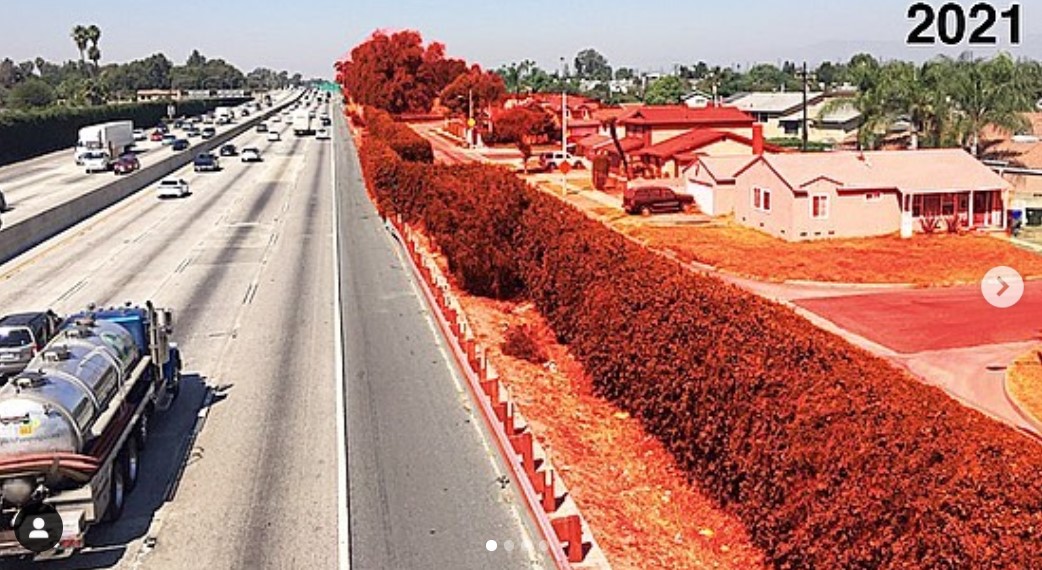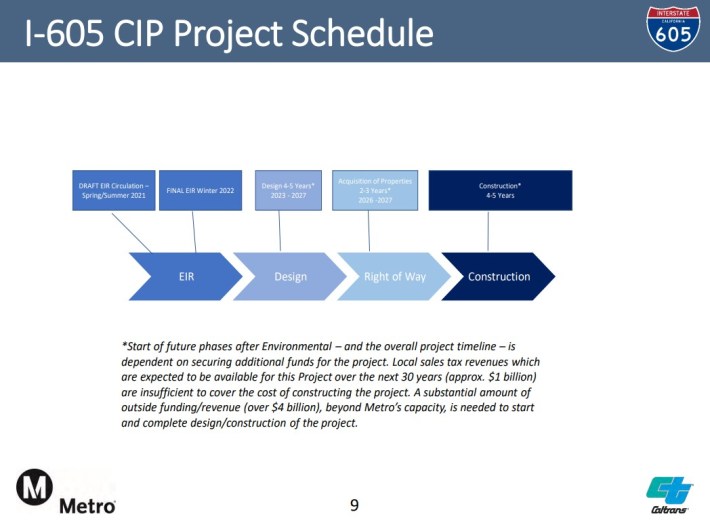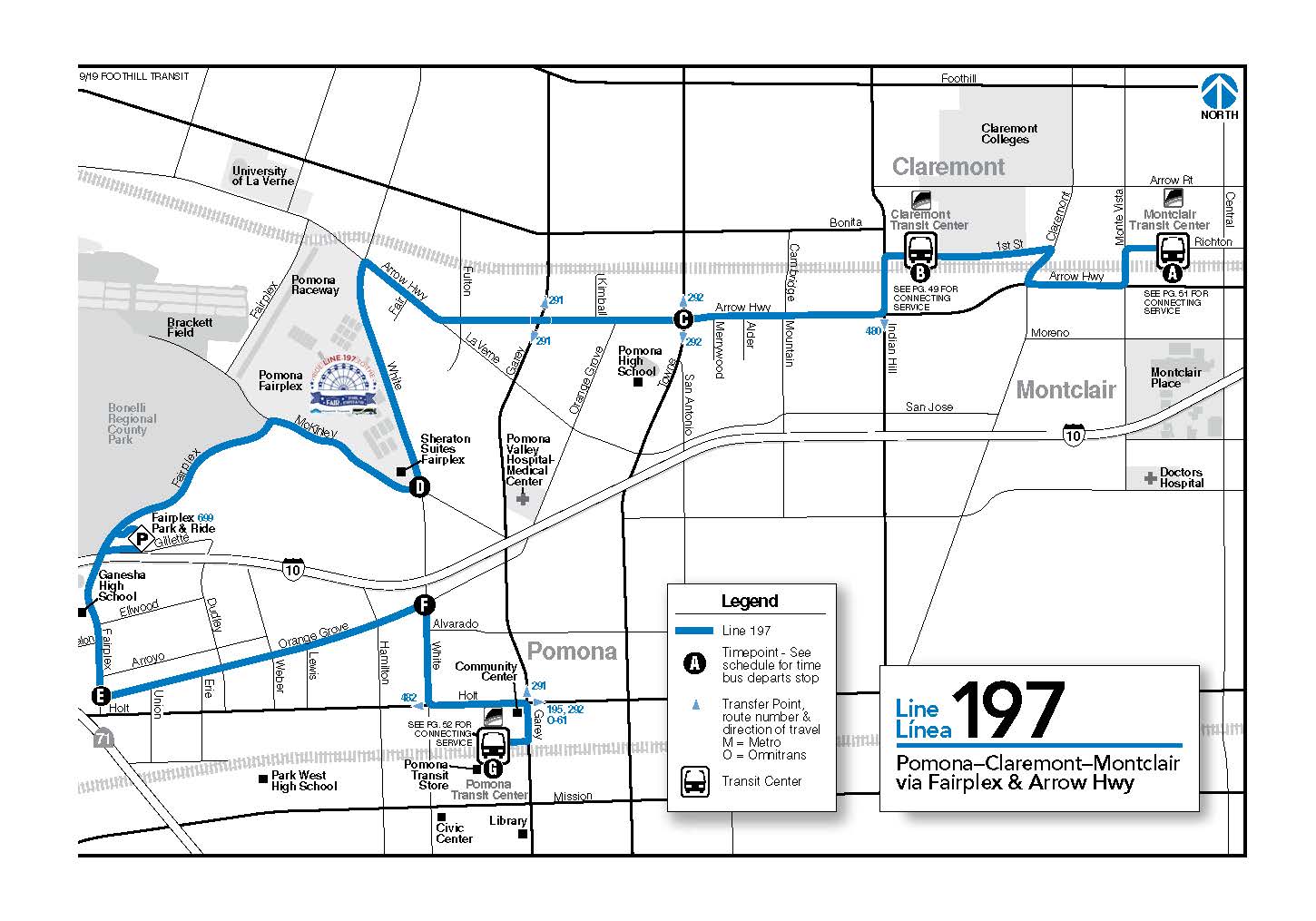Corridor Cities Debate Metro’s Planned 605/5 Freeway Widening
11:18 AM PST on February 25, 2021

Visualization of Downey homes threatened by Metro and Caltrans 5 Freeway widening – via segregation_by_design Instagram
Metro is proceeding to finalize plans to widen freeways in southeast L.A. County. Details remain elusive on a new slightly-less-harmful alternative for Metro and Caltrans’ 605 Freeway Corridor Improvement Project, though Metro presented the project at last night's Gateway Cities Council of Governments’ 91/605/405 Freeways Corridor Cities Committee meeting (agenda packet - includes Metro presentation starting on page 82). There wasn't a lot of new information in yesterday's presentation, but the discussion was instructive.
The 605CIP would spend over five billion dollars to widen about 15 miles of the 605, plus other intersecting freeways. It includes about three miles of the 5 Freeway where the project would demolish hundreds of homes. After Metro announced the planned demolitions last summer, many individuals and groups expressed opposition. Metro then delayed the scheduled project approval to come up with less destructive alternatives. At a Technical Advisory Committee meeting in late January, Metro presented scant information on a new project alternative that would still demolish hundreds of homes.
This was only the the second public meeting where Metro's new alternative has been presented, if you can call it that. Though it's clear that it still calls for demolishing hundreds of homes, the proposal remains vague, sketchy.
Last night's public comment was heavily against the project. Prior to the meeting, the committee received 70 email comments opposed to freeway expansion. At the meeting, another twelve commenters testified in opposition, asserting that the project is antiquated, unnecessary, short-sighted, causes more congestion, and is harmful to housing and the climate.
Metro Project Manager Isidro Pánuco gave more detail about the location of outreach meetings in 2016 than he did about the locations of homes threatened by the project.

Pánuco and Metro Highway Program Director Ernesto Chaves sought to reassure the committee - and the public - with some unreassuring talking points:
- "We're trying to impact only one side of the freeway through Downey - not both." What do you want to damage, Downey, your park or your school? (in addition to hundreds of homes)
- Metro stated that the project is currently "only funded through the environmental plans - no acquisition, or bulldozing of homes." Should Downey residents be reassured that Metro is only making plans to bulldoze their homes? Why would Metro make those plans if they don't intend to fund and implement them?
- The presentation included a new timeline (slide above). Should residents be reassured that demolition is currently scheduled for 2026?
- Metro touted "a lot of benefits that ease the pain" of relocations: moving assistance, tax-transfers. These benefits were later noted to be only available for elderly residents.
- Pánuco touted the project's benefits for transit - but later, responding to a question from County Supervisor Janice Hahn's Senior Transportation Deputy Luke Klipp, Metro staff explained that the transit enhancement would be improvements to express lanes that could be used by transit that could run on the freeway in the future.
- Pánuco said that Metro's new alternative proposal had been developed through "6+ meetings with local jurisdictions, GCCOG, I-5 JPA, and Caltrans." Responding to questions, Metro made clear that these were technical meetings, not open to the public. Hahn Deputy Klipp questioned how many public meetings would be held for input on the project's Environmental Impact Report (EIR), noting that when the EIR was planned to be released last September, Metro had announced just one public meeting. Metro staff responded that there was "no defined number" of meetings planned, but that it would be "a little bit more robust than one meeting."
Klipp noted that Supervisor Hahn's chief concern on the 605CIP was a "lack of community engagement." He further noted that the board instruction - from last October - was for Metro Highways Program to engage stakeholders in developing a new alternative. Metro staff made it clear that they had taken a different tack. They developed their new alternative in closed-door meetings, then sought GCCOG committee approvals, then will present the new alternative to the Metro board, then will create an outreach plan. This is typically known as "publish and defend" and is pretty much the opposite of meaningful community input.
The Corridor Cities Committee consists of elected officials, mostly mayors, from Gateway Cities. Though public comment was solidly opposed, committee members were somewhat split on how to proceed with the project.
Santa Fe Springs Councilmember Joe Angel Zamora was the only committee member to voice strong support for moving forward with the freeway expansion. Santa Fe Springs is at the current bottleneck of the 5 Freeway. Zamora's city is slated to lose dozens of homes to 605CIP construction, with demolitions numbering second only to the city of Downey. Zamora asserted that if the project doesn't move forward, the money would go somewhere else. Zamora touted project benefits, including reduced congestion getting drivers home to their families sooner and less wear and tear on city streets. Though Metro and Caltrans do frequently claim their freeway projects will reduce congestion and get traffic off of local streets, extensive research shows that freeway expansion projects induce more driving, worsening congestion and traffic.
Downey Mayor Claudia Frometa voiced her opposition to Metro's new alternative. Her city would bear the brunt of demolitions: hundreds of homes, apartments, businesses, a school and a park. Downey would also become the new bottleneck (until Metro expands the 5 Freeway north, as funded in Measure M). Frometa decried the new Metro alternative as still "decimating neighborhoods" and "eliminating generational wealth." Frometa stated that she would "advocate for Downey one hundred percent" and push for an alternative that would "eliminate these impacts."
I will continue advocating for our residents and ensure there is public engagement. We must be vocal with Metro and request alternatives that do NOT impact our neighborhoods. The release of this Environmental Impact Report will give everyone an opp. to speak up!
— Claudia M. Frometa (@ClaudiaFrometa) February 25, 2021
Mayor Frometa expressed support for a possibility raised by Whittier City Councilmember (and likely future Metro boardmember) Fernando Dutra: split the 605CIP up into phases, starting with easier, less-impactful phases - and potentially eliminating harmful phases.
Ultimately, the Corridor Cities Committee approved the motion to include Metro's new alternative in the 605CIP environmental document, but amended the motion to direct Metro to come back to the Corridor Cities Committee with a public outreach plan to be approved by the committee.
Stay in touch
Sign up for our free newsletter
More from Streetsblog Los Angeles
No, L.A. City Does Not Always Add Required ADA Ramps During Resurfacing, But They Should
StreetsLA GM Keith Mozee "Any time we do street resurfacing, it is considered an alteration, which requires ADA ramps to be installed."
LAPD Was Crossing Against Red Light in Crash that Killed Pedestrian and Injured Six in Hollywood
The department says the officers had turned on their lights and sirens just before crossing, but won't say why they did so.




